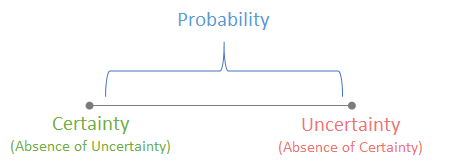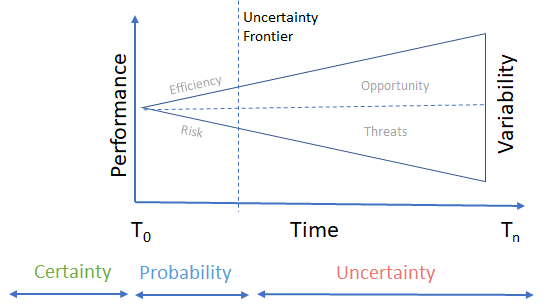For organisations looking to get the most out of their Driver based planning and Rolling Forecasting...
 For many organizations, the strategy gap is a major obstacle that systematically prevents businesses from truly maximizing their Strategic Planning efforts and sustainably creating value for their organization.
For many organizations, the strategy gap is a major obstacle that systematically prevents businesses from truly maximizing their Strategic Planning efforts and sustainably creating value for their organization.
So, what are the underlying causes that routinely lead us down this same perilous path year-after-year? Should all the blame be placed on competitive and/or volatile markets? Or are we failing to apply the right management processes to a reoccurring and well-known business problem?
I believe the answer to this question lies in how we choose to view and embrace uncertainty.
By changing our attitude and approach to uncertainty, perhaps we can produce both meaningful and agile strategies that can actually be executed each and every year, thus eliminating the strategy gap as we know it once and for all.
The Fear of Uncertainty
The natural inclination for anything we fear is to avoid it and such is the case with uncertainty.
Rather than embrace uncertainty, we often throw our hands up or worse provide mindless projections (ex. escalation rates) that no one believes in nor takes seriously.
This default approach to uncertainty not only limits our thinking, it also limits our business potential.
Understanding Uncertainty
So, what is uncertainty? The mistake many people make when defining uncertainty is to infer the prefix “un” to mean “not”. Under this thinking, “uncertainty” would mean “not certain”, which would equate to a blanket statement for anything that is not known.
In reality, the prefix “un” in uncertainty actually means “a lack of” or an absence of certainty. This provides a much more meaningful definition as it establishes a range or spectrum for predictability.

What lies in-between certainty and uncertainty is what we call probability (that which has some measurable degree of certainty).

The Window of Probability
In FP&A terms, this spectrum can also be associated with a time range, what I like to call a “window of probability”.
The window of probability may be different by organization, but for most organizations it typically equates to a 12-18 month view into the future. Everything after that tends to look too murky to predict.
Of course, it’s possible that the window can grow and shrink from year-to-year, but for the most part healthy organizations and the markets they operate in tend to keep the size of this window constant.
But regardless of the size of the window, what’s important to realize is that for FP&A, the window of probability is where the fertile ground is located. This is because probability represents measurable risk and anything that is measurable is manageable and process management is what FP&A does best.
By building up significant control and command processes FP&A can work to squeeze out as much performance as possible, all the while keeping the tolerance for variability low.
Understanding the Value of Uncertainty
As we attempt to move out into longer-term planning (strategic planning), we tend to find ourselves operating squarely in the realm of uncertainty.

Uncertainty is a completely different beast than probability. Uncertainty is by definition impossible to predict and is always changing, like a computer generated password that is re-scrambled continuously.
But uncertainty, is also where the majority of the value lies. Ignoring uncertainty or trying to use the same processes and tools used to address the window of probability is where most organizations falter.
In short, uncertainty is where strategy is developed. Probability is where strategy is executed.
How should organizations approach uncertainty
How organizations approach uncertainty is the key to building meaningful and attainable goals. Below are 11 ways in which organizations can pivot from a predictable world to a world of uncertainty.
1 - Switch to Screening for Real Options
Uncertainty is not only impossible to predict, but it is also continuously changing. Therefore, the best way to approach uncertainty is by switching to real options. A Real Option often represents the potential outcome of an entire SBU or Asset. This is different from traditional planning where the focus is on line item forecasting. Real Options are particularly valuable because you’re always screening/testing multiple options at a time in order to understand which direction is the best way to proceed.
2 - Develop Multiple Views of the Future
In addition to screening for Real Options, it’s important to maintain multiple views of the future as well. A simple way to do this is to evaluate different real options under different risk scenarios (expected, down turn, deep down turn, etc.). Having this point of view will enable you to make strategic choices that will still pan out even if the economy takes a down turn in the future.
3 - Focus on Moving Constraints
The upside to uncertainty is that you often have several years in front of you. We need to focus that time on breaking down barriers and creating obstacles for our competitors to follow. This is what strategy is all about. Short-term tactical planning benefits from a greater level of probability, but it is virtually impossible to move constraints in the short-term.
4 - Look for Long-Term Value
As we showed in the graph earlier, organizations can create value for their shareholders if they are able to take advantage of uncertainty.
Efficiency can help grow the bottom line temporarily, but it’s not where the sustainable value is created.
5 – Focus on Calibration
One of the biggest challenges when trying to embrace uncertainty is understand what level of detail is necessary to help guide you. Unfortunately, there isn’t a magic answer for this question, but organizations must continuously look to optimize their models in order to stay relevant.
Resist the urge to collect more data in a failed attempt to eliminate doubt.
6 – Know what you are Measuring
Uncertainty represents an opportunity for organizations to deliver world class strategy and that should always be tied back to shareholder value (share price).
Conversely, Earnings represent a partial view of the world and take the focus away from making strategic investments. As a result, Earnings is a far better measurement for tactical planning.
7 – Be Ready to Tell Your Story
Uncertainty is all about making strategic investments and measuring cash flow over time.
Don’t rely on KPIs which can be misleading as they rarely take into account any concerns around time value of money and often rely heavily on accounting treatments.
8 – Pick the right tools
In order to address uncertainty, you need to have tools that are not only agile, but also promote alternative discussion and debate. This usually means “Edge” based tools.
“Core” tools are great for centralizing the discussion and are therefore optimal for tactical planning, but these solutions are often limited when it comes to dealing with uncertainty.
9 – Adopt a Culture of Collaboration
The best way to address uncertainty is by enabling your peers to “suggest” alternatives. This is a critical form of collaboration under uncertainty because it is the key to promoting discussion and debate around alternative perspectives.
This is the opposite approach to “submission” based planning where alternative ideas are excluded from the process.
10 – Become an Influencer
Uncertainty favors individuals who have the skills to successfully influence their peers and help create lasting value for their organizations
Sure, we’re all familiar with presenting our findings, but under uncertainty, the real work happens long before the presentation starts.
11 – Question the Status Quo
Sometimes the best approach to uncertainty is to ask questions. Asking questions can help uncover problems and ultimately help teams produce optimal plans under uncertainty.
Spending all your time simply justifying outcomes can be a dangerous approach when dealing with uncertainty as it often restricts future agility and cohesion.
Conclusion
Closing the strategy gap for good requires organizations to put forth meaningful and attainable strategic targets that inspire and reward those who are responsible for it’s execution. However, it also requires building management processes that can navigate uncertainty. Failing to identify or hide from uncertainty will cause organizations to lose sight of what is really important.
The article was first published in Prevero Blog
Subscribe to
FP&A Trends Digest

We will regularly update you on the latest trends and developments in FP&A. Take the opportunity to have articles written by finance thought leaders delivered directly to your inbox; watch compelling webinars; connect with like-minded professionals; and become a part of our global community.


